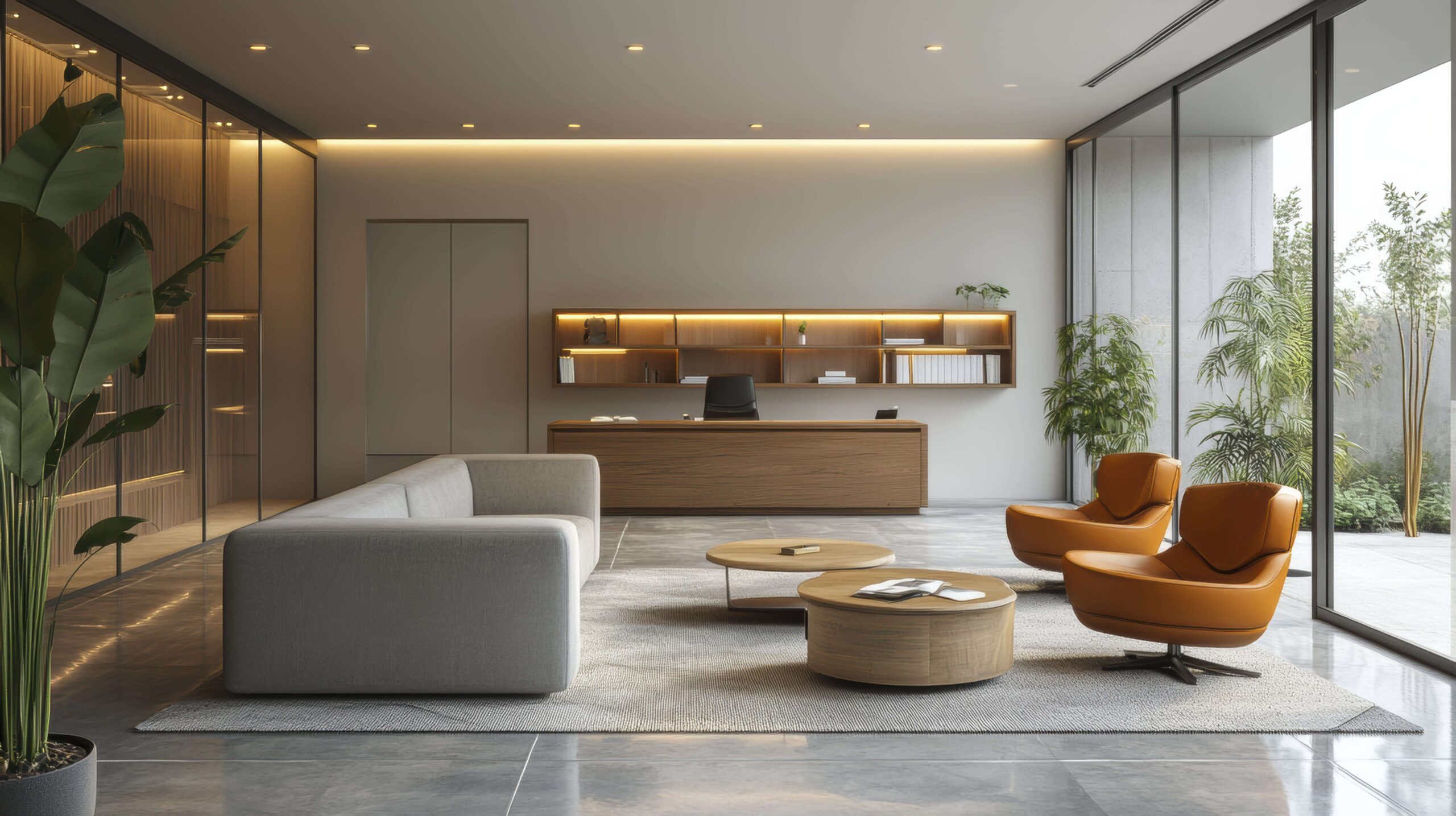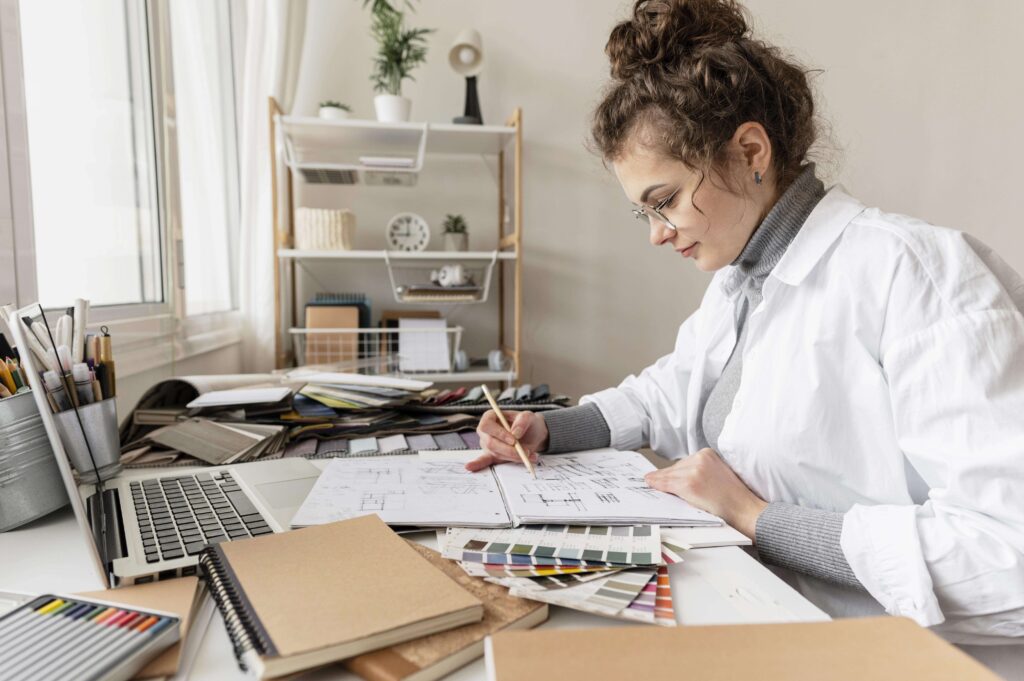
Across the UK, many people share the same quiet frustration. They walk through cramped rentals, awkward new-build layouts, or offices with harsh lighting and wonder why spaces here so often feel “almost right” but never quite work. This everyday struggle revealed a bigger challenge: countless people love interiors yet have no idea how to turn that interest into real design skill. As a result, they search for clarity on how to become an interior designer but feel lost between mixed advice, unclear routes, and confusing expectations. Questions appear quickly—What qualifications matter? How much creativity is enough? And how do you break into the field? With the right steps, the path becomes far easier to navigate.
Table of Contents
Understanding the Interior Designer Role
Before making big decisions, you need a clear picture of the job. Anyone asking how to become an interior designer must first understand the day-to-day work. An interior designer does far more than choose cushions or paint colours. Instead, they work with both function and feeling.
An interior designer shapes how people move, work, and relax inside a space. They consider safety rules, lighting, materials, and how each area should feel. They also think about long term use and maintenance, which matters when you plan how to become an interior designer for serious clients.
Typical tasks include:
Meeting clients and understanding their goals and budgets
Creating mood boards and early design concepts
Planning layouts and circulation through each room
Choosing finishes, materials, and furniture pieces
Coordinating interior decoration details and accessories
Working with contractors, suppliers, and other specialists
Checking the finished space and solving any final issues
Because the work is varied, interior design suits people who enjoy both creativity and problem solving. It also suits people who like practical decisions, not just pure art. If you enjoy this balance, you already understand part of how to become an interior designer in a smart way.
Interior Designer vs Interior Decorator
Many people use these terms as if they mean the same thing. However, there is an important difference, and it affects how to become an interior designer in the UK.
Interior design looks at the whole space. It covers layout, structure, function, and the overall user experience. Interior designers think about wiring, plumbing, building rules, and safety as well as style. Serious interior design work always goes beyond simple surface choice.
Interior decoration sits on top of that structure. It focuses on surface choices and finishing touches. It includes fabrics, colours, artwork, rugs, lamps, and smaller details. Interior decoration is vital, yet it is only one part of how to become an interior designer who can handle full projects.
You can imagine it this way:
Interior design = how the space works
Interior decoration = how the space feels and looks
In real life, many UK jobs blend both. Therefore, learning both interior design and interior decoration will make you more useful and employable. If you are thinking about how to become an interior designer with strong career options, you should plan to cover both areas.
Key Skills Every Interior Designer Needs
To become an effective interior designer, you need a mix of abilities. Some are technical. Others are about people and planning. When you study how to become an interior designer, you will see these skills appear again and again.
Core creative and technical skills
Spatial awareness
You should see how shapes, furniture and people interact inside a room. This helps you plan layouts that feel natural and safe. Strong spatial awareness sits at the heart of interior design.Colour sense
You must understand how colours affect mood, light, and perception. Good colour choices support both design and interior decoration. When you learn how to become an interior designer, colour is one of your main tools.Drawing and visualisation
You do not need to be a fine artist. However, you should sketch ideas and read plans. Over time, you also learn digital tools for drawings and 3D views. Clear visualisation helps clients trust your interior design ideas.Software confidence
Interior design uses tools like Revit, CAD, and 3D modelling programs. Studyhub offers a Revit Architecture Interior Design Course, which helps you build these skills. Software confidence is now a core part of how to become an interior designer in modern studios.
Soft skills and professional abilities
Communication
You speak with clients, suppliers, and contractors. Clear language prevents costly mistakes and supports smooth interior design projects.Organisation
You handle budgets, timelines, and many small details. Strong organisation keeps projects on track. Good organisation also supports a stronger interior designer salary over time.Negotiation
You often negotiate prices and schedules. Good negotiation protects your client and your own reputation. It becomes vital when you plan how to become an interior designer who runs complex work.Problem solving
Things go wrong on site. You must stay calm, think clearly, and offer practical solutions. Strong problem solving skills keep interior design projects moving, even under pressure.
Interior design is not only about talent. These skills grow with training, practice, and feedback. As you progress through each stage of how to become an interior designer, you will build these skills layer by layer.
Routes into Interior Design in the UK
There is no single fixed route in the UK. Instead, you can build your career in several ways. That is helpful if you discover interior design later in life or while working. This flexibility is important when you are planning how to become an interior designer around other duties.
Main paths into the profession
Here is a simple comparison of common routes.
Route type | Strengths | Things to consider |
University degree in interior design | Strong theory and practice, good network | High cost and longer study period |
College or FE course | Practical focus and smaller classes | Less flexible if you already work |
Online courses (Studyhub) | Flexible, affordable, study from anywhere | Requires discipline and self-motivation |
Apprenticeship or trainee role | Learn on the job, earn while learning | Places are limited in this field |
Self-taught plus portfolio | Very flexible, low direct cost | Harder to prove skills at first |
Because interior design is portfolio-driven, you can combine routes. For example, you might start with online interior design courses from Studyhub, then move into a trainee role. Many people who ask how to become an interior designer start with small online steps, then grow into formal work.
Interior Designer Salary in the UK
Money is not the only reason to choose a career. However, it still matters. Therefore, you need a realistic view of interior designer salary in the UK when planning how to become an interior designer.
Pay changes with location, experience, and the type of employer. London and large cities often pay more. Smaller firms and towns sometimes pay less. Freelancers may earn more in busy periods and less at quiet times. Interior designer salary can also grow faster if you handle both interior design and interior decoration well.
Here is a simple guide. Actual figures will vary.
Career stage | Typical situation | Approximate annual range* |
Trainee / Assistant | Supporting designers, still learning | |
Junior Interior Designer | Handling small tasks, some client contact | |
Mid-weight Interior Designer | Managing projects with guidance | |
Senior Interior Designer | Leading projects and mentoring others | |
Freelancer / Studio owner | Running own projects and clients | Highly variable, project-based (no fixed gov link) |
Interior designer salary usually grows as your skills, portfolio, and client base improve. Strong business skills and good networking can increase income over time. When you map out how to become an interior designer, remember that smarter choices can boost your long term earnings.

A Simple Roadmap: How to Become an Interior Designer
Because there are many moving parts, it helps to see a clear path. The steps below give a practical order. Each step moves you closer to how to become an interior designer with real, paid work.
Step 1: Explore and decide
You start by taking your interest seriously. Look at interiors wherever you go. Notice why some rooms feel calm and others feel stressful. Keep a simple notebook with ideas. This small habit supports your wider plan for how to become an interior designer.
At this stage, reading, watching videos, and visiting design shows can help. You just want to confirm that interior design truly fits your nature before you invest more.
Step 2: Learn the foundations
Next, you need structured learning. You learn design principles, space planning, lighting basics, and interior decoration skills. This foundation is a core part of how to become an interior designer in any country, including the UK.
You might choose courses such as:
These Studyhub courses explain how to think like an interior designer, not just a hobby decorator. Because they are online, you can study around work or family duties. This makes how to become an interior designer more realistic for busy adults.
Step 3: Build practical projects
Once you understand the basics, you must apply them. Start designing real or mock spaces. Practical work is central to how to become an interior designer with a strong portfolio.
For example, you could:
Redesign a bedroom with a complete new layout
Plan a small café with a clear concept and flow
Create a children’s room using ideas from Creating Children’s Room: Kids Rooms Interior Design
Practise staging a home using Interior Design: Styling & Staging
Each project should include drawings, mood boards, and a clear explanation of your choices. These become early portfolio pieces and prove you are serious about interior design and interior decoration.
Step 4: Add specialist skills
As confidence grows, you can add targeted skills. Studyhub has useful options here. This step helps you move from basic knowledge to deeper levels of how to become an interior designer with a clear niche.
You might choose:
Interior Design: Space Planning for deeper layout skills
Mastering Colour – Architectural Design & Interior Decoration for advanced colour work
Curtains & Blinds in Interior Design to handle window treatments professionally
Furniture Restoration and Painting to bring new life to older pieces
Interior Design Masterclass Certificate for higher-level design thinking
Although this looks like a lot, you do not need them all at once. You can build your skill set gradually. Many people spread these steps over several years as they work through how to become an interior designer at a steady pace.
Step 5: Learn key software
Digital tools now sit at the heart of interior design. Many studios expect basic competency in design software. If you want to know how to become an interior designer that employers trust, software skills matter.
The Revit Architecture Interior Design Course from Studyhub can give you a strong start. You can also explore other tools over time, such as CAD or visualisation programs.
Software skills help you:
Produce clear floor plans
Create 3D views that impress clients
Communicate accurately with builders and suppliers
Step 6: Build a portfolio
A good portfolio can open doors even before you hold a formal job title. A strong portfolio is the practical proof behind every story about how to become an interior designer from scratch.
Your portfolio should include:
Three to five complete projects
A mixture of residential and commercial designs, if possible
Floor plans, elevations, or 3D images
Mood boards that show interior decoration choices
Short text explaining the concept and key decisions
You can host your portfolio online or in a PDF. Make sure images are clear and well labelled. Over time, your portfolio becomes the core tool in your plan for how to become an interior designer with regular clients.
Step 7: Gain experience and feedback
Experience helps you test your skills in real situations. There are several ways to start. This stage turns theory about how to become an interior designer into real client work.
You might:
Look for assistant or junior roles in design studios
Help local businesses improve their interiors at low cost
Join property staging teams or furniture showrooms
Offer small redesign packages to friends and family
Every project gives more than money. It gives feedback and proof of progress. It also helps you understand what type of interior design you enjoy most. This insight supports smarter choices around interior designer salary and future roles.
Step 8: Plan your long-term path
With skills, portfolio, and some experience, you can plan the long game. Long-term planning is the final stage of how to become an interior designer with a stable career.
You might decide to:
Stay in employment and climb to senior designer level
Switch to freelance interior design work over time
Build your own studio and hire others
Business training can also help. Courses like Professional Interior Design & Construction support designers who want to manage projects more confidently.
Conclusion
Becoming an interior designer in the UK is not a single leap. It is a series of manageable steps. You first explore your interest. Then you learn the foundations of interior design and interior decoration. After that, you practise with real projects, build software skills, and develop a strong portfolio. Over time, interior designer salary grows as your competence and reputation increase.
You do not need to follow one perfect route. Instead, you combine learning, practice, and experience in a way that fits your life. When you understand how to become an interior designer in clear stages, the process feels less scary. You can start today, one module at a time, and slowly build the career you want inside this creative and rewarding field.
FAQs
You don’t need a specific qualification by law in the UK. However, most employers prefer a diploma, Level 3–5 qualification, or a degree in interior design or a related field. A strong portfolio is more important than the qualification itself.
The 3-4-5 rule is a simple ratio used to create balanced room layouts. It helps designers plan proportions where the width, height, and diagonal follow a natural visual order. It is often used to create pleasing room shapes and furniture placement.
You don’t need specific GCSE or A-level subjects, but art, design, graphics, and technology are helpful. For further study, interior design courses often require basic design skills, creativity, and a portfolio rather than strict subject requirements.
The seven basics are space, line, form, light, colour, texture, and pattern. These elements guide balance, mood, and function in a room, and every interior design project uses them to shape the final result.
In the UK, pay varies by region and experience. Junior designers earn around £22,000–£28,000, while senior designers can earn £35,000–£50,000+. Freelancers may earn more depending on clients and project size.
- All Courses
- IT & Software375
- Management273
- Teaching and Education247
- Business231
- Health and Fitness211
- Health & Safety158
- Engineering & Technology150
- Quality Licence Scheme136
- Health and Social Care134
- Healthcare128
- Accounting & Finance117
- Employability103
- Psychology99
- Lifestyle92
- Marketing74
- Office Productivity65
- Animal Care56
- Design and Photography53
- Design44
- Beauty & Makeup42
- Accounting & Bookkeeping32
- Web Development27
- Writing20
- Construction15
- Digital Marketing12
- Child Care10
- Environment9
- Agriculture5
- Coaching1
Awarded By





0 responses on "How to Become an Interior Designer in the UK"